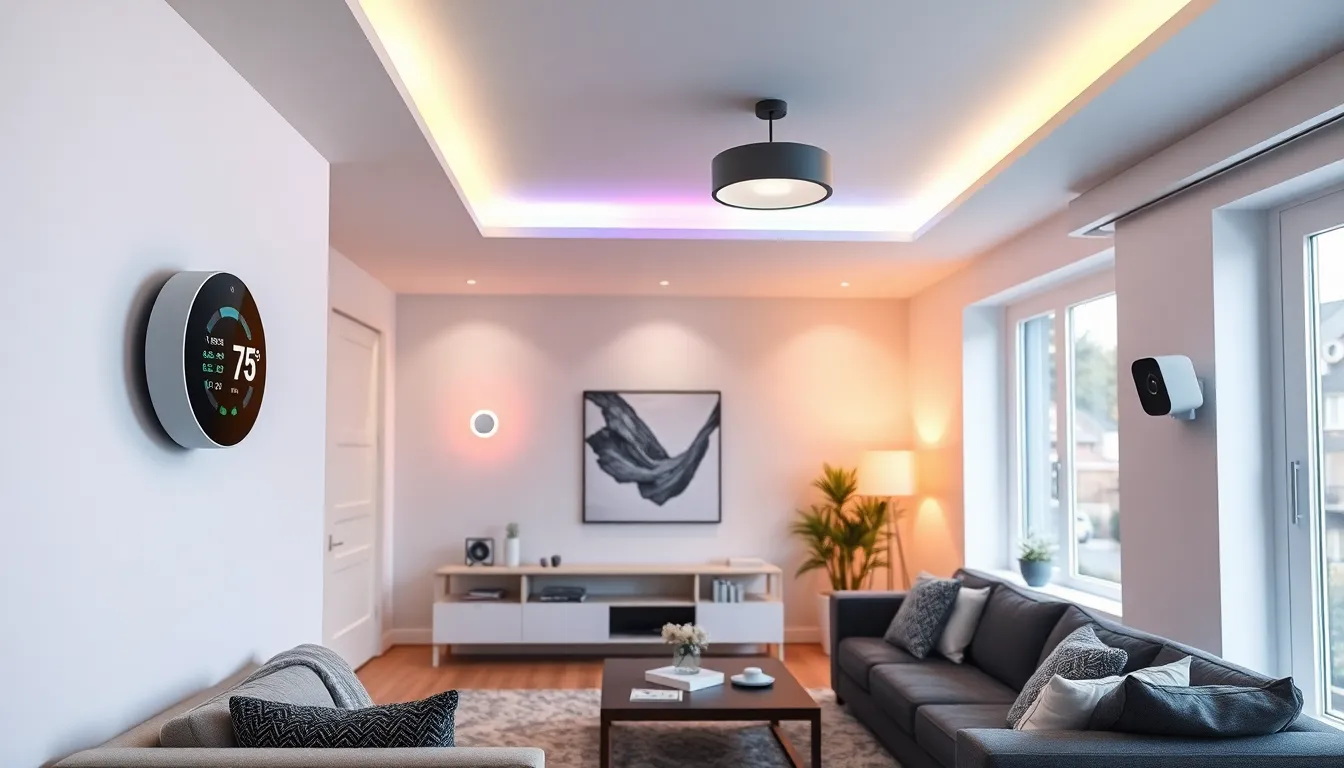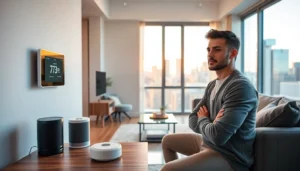Table of Contents
ToggleImagine walking into a home that greets you like an old friend, dimming the lights and playing your favorite tunes as if it knows your every whim. Welcome to the world of smart homes! These tech-savvy havens are designed to make life easier, more efficient, and a little more fun. But with so many gadgets and gizmos out there, it can be tricky to figure out which ones truly belong in this high-tech paradise.
Overview of Smart Homes
Smart homes incorporate various technologies that automate and enhance daily living. These homes often include devices such as smart thermometers, which maintain optimal temperatures based on preferences. Security systems like smart locks provide safety and can be monitored remotely via smartphones.
Connected lighting systems allow homeowners to adjust brightness and color temperature easily. Voice-activated assistants enable effortless control over various devices, simplifying daily tasks. Smart appliances like refrigerators can notify users when food items are running low.
Energy management is another critical aspect of smart homes. Smart thermostats learn user schedules and optimize energy consumption, significantly reducing utility bills. Surveillance cameras enhance security by offering real-time video feeds accessible from mobile devices.
Integration of these devices through a centralized hub streamlines control. Homeowners gain the ability to execute multiple functions with a single command. The convenience of automation helps to create personalized living environments tailored to individual needs.
Despite the abundance of smart devices on the market, careful selection ensures compatibility and functionality. Assessing features such as energy efficiency and ease of use assists in creating an ideal smart home setup. Ultimately, a smart home enhances comfort, security, and efficiency, making everyday life more enjoyable.
Key Components of a Smart Home

Smart homes integrate various advanced technologies to improve daily living. The combination of devices enhances convenience, security, and energy efficiency.
Smart Security Systems
Smart security systems offer advanced protection for homes. Features like smart locks enable remote monitoring and secure access. Surveillance cameras deliver real-time video feeds, which users can access through mobile devices. Some systems allow for alerts about suspicious activities, providing peace of mind. Integration with home automation systems enables seamless security management, enhancing overall safety.
Smart Lighting Solutions
Smart lighting solutions create customized atmospheres in living spaces. Homeowners can adjust brightness and colors according to their preferences. Integration with voice-activated assistants makes controlling lights effortless. Scheduling options allow for automatic adjustments based on the time of day. These systems also promote energy efficiency by using LED bulbs that consume less power compared to traditional lighting.
Smart Thermostats
Smart thermostats optimize energy use for heating and cooling. Users can program their preferences and monitor energy consumption remotely. Features like learning algorithms adapt settings based on the homeowner’s habits. This leads to significant savings on utility bills while maintaining comfort. Integration with other smart devices creates a cohesive energy management solution.
Smart Appliances
Smart appliances enhance convenience in everyday tasks. Refrigerators can alert users when groceries run low, minimizing waste. Smart ovens offer remote control and cooking precision, improving meal preparation. Washing machines with smart technology allow for scheduling and monitoring cycles from mobile devices. These appliances increase efficiency while simplifying household management.
Benefits of Smart Home Technology
Smart home technology provides numerous advantages that improve daily living. It enhances convenience and control, while promoting energy efficiency.
Convenience and Control
Smart home devices simplify everyday tasks. Homeowners manage lighting, temperature, and security systems through mobile apps or voice commands. Voice-activated assistants allow individuals to execute commands without needing physical interaction. Automation features enable scheduling, like adjusting the thermostat for comfort before arriving home. Additionally, remote access to surveillance cameras enhances peace of mind. Overall, convenience increases, and control over various home functions becomes seamless.
Energy Efficiency
Smart home technology significantly reduces energy consumption. Smart thermostats automatically adjust temperatures based on schedules and preferences, leading to lower utility bills. Similarly, connected lighting systems use sensors to optimize brightness according to occupancy. Smart appliances track usage patterns, sending alerts when efficiency drops. As users adopt energy-saving habits, they see tangible cost savings. These technologies provide insights into energy use, encouraging homeowners to make informed decisions.
Considerations When Choosing Smart Home Devices
Selecting smart home devices requires careful thought. Understanding compatibility and integration offers a foundation for a successful setup.
Compatibility and Integration
Compatibility ensures devices work seamlessly within a smart home environment. Common protocols like Zigbee, Z-Wave, and Wi-Fi facilitate communication between devices. Many manufacturers design products to integrate with major platforms such as Google Home and Amazon Alexa. Users must verify if new devices harmonize with existing systems. The ease of integration can affect overall user experience, especially with multiple devices. Centralized hubs can manage various gadgets, simplifying control and enhancing automation features. A cohesive ecosystem maximizes functionality and supports efficient home management.
Security and Privacy Concerns
Security ranks high among considerations for smart home devices. Vulnerabilities in connected devices can pose risks, from unauthorized access to data breaches. It’s crucial to choose devices with robust encryption and regular software updates. Users should examine the privacy policies of manufacturers to understand data usage. Implementing strong, unique passwords for networks further safeguards against potential attacks. Monitoring connected devices and setting alerts for unusual activities enhance security measures. Layered defense strategies create a more secure smart home environment, protecting both personal information and physical spaces.
Embracing smart home technology transforms everyday living into a seamless experience. By integrating devices like smart thermostats, security systems, and voice-activated assistants, homeowners can achieve greater comfort and efficiency. The ability to control lighting, temperature, and security remotely not only enhances convenience but also contributes to energy savings.
Selecting the right devices ensures a cohesive ecosystem that maximizes functionality while addressing security and privacy concerns. As smart homes continue to evolve, the benefits they offer will only grow, making them an attractive option for those looking to improve their living spaces. Adopting smart home technology is more than just a trend; it’s a step towards a more connected and efficient lifestyle.






